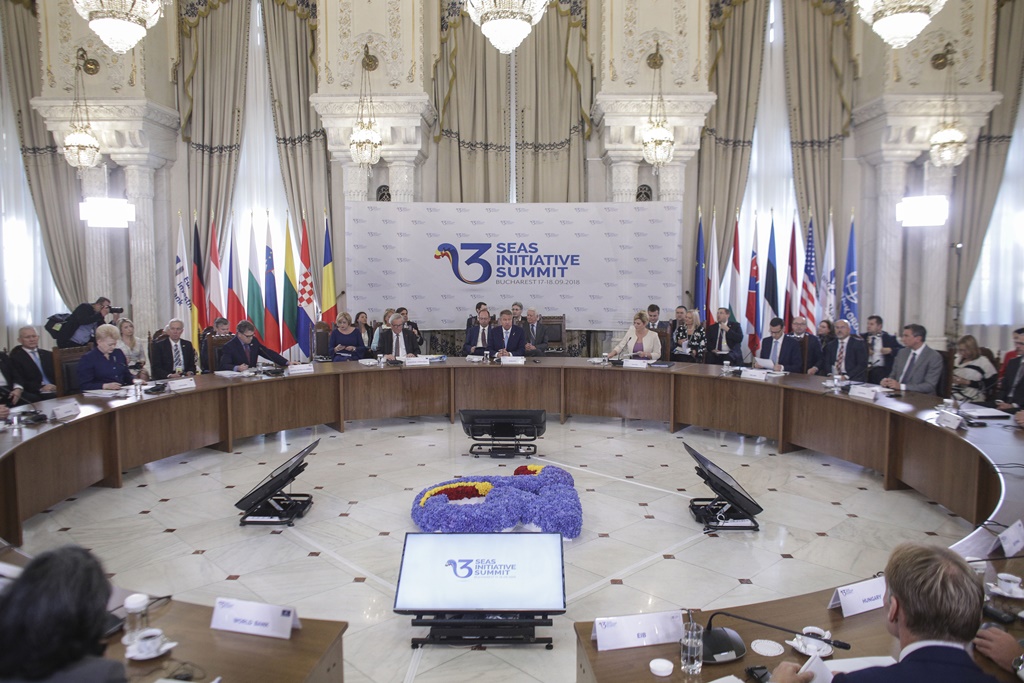PISM Spotlight: Three Seas Initiative Summit in Bucharest: Vision Becoming Reality

The Bucharest summit of the Three Seas Initiative (TSI) signalled that this regional cooperation format is coming of age. The summit gathered delegates from all TSI countries (Austria, Bulgaria, Croatia, Czech Republic, Estonia, Hungary, Latvia, Lithuania, Poland, Romania, Slovakia, and Slovenia), eight of which were represented by heads of state. The significance of TSI is acknowledged by the European Commission (EC). Germany took part in the TSI summit for the first time and the U.S. for the second time. The participation of senior officials from international financial institutions in the TSI Business Forum, as well as the decision to set up the Three Seas Fund was a welcome signal to the business community.
What are the key political deliverables of the summit?
The initial scepticism of the EC towards TSI seems to have been overcome. The summit was attended both by the head of the Commission and the Commissioner for Regional Policy. Thus, the EC recognises TSI’s role in strengthening EU cohesion. Germany sent its minister of foreign affairs, formally as an observer. The German interest in TSI stems from both the recognition of economic benefits from tighter integration in a region of considerable importance to the German economy, as well as anxiousness about possible Chinese investment in TSI. In addition, Germany could see consistent U.S. support for TSI—especially in light of U.S. opposition to Nord Stream 2 (NS2)—as an indication that the United States has much more to offer to Europe’s energy security than the prospect of levying sanctions against NS2.
What is the Three Seas Fund (TSF)?
State development institutions from six TSI countries—Croatia, Czech Republic, Latvia, Poland, Romania, and Slovakia—declared their intent to set up the TSF. The fund would be open to all TSI members and tasked with attracting financial support for transnational infrastructure projects involving at least three TSI states. Financing for these projects is to come from the founding institutions (up to €5 billion) and international private funds, such as pension funds or sovereign wealth funds. All in all, the aim is to attract long-term investors. The fund itself would be established for 30 years and the TSF’s backers expect that overall financing will reach €100 billion, a twenty-fold increase in the founding capital.
What are the prospects for setting up permanent TSI structures?
There is no need since the mode in which TSI has developed so far as a loose cooperation format with heads of state setting the pace has proved effective. At the same time, the ultimate success of TSI will depend on the support—both in content and organisation—of the government administrations in its respective member states. Creation of the TSF and its governing structures—a team to handle the invested assets and a board of directors gathering representatives of the states involved in the fund—is a nod to the private sector. The TSF thus will act as TSI’s business interface of sorts. Formats created under the TSI brand—cooperation between national chambers of commerce or the Regions Forum, launched in July 2018—will serve a supporting role rather than become the avant-garde of the initiative’s permanent structures.
What comes next for TSI?
Slovenia will host the next TSI summit. It will likely make an effort to underline the initiative’s complementarity with projects supported by EU institutions. In the meantime, most probably until the end of 2019, the TSF will be established and equipped with its governance structures. A thorough assessment of the TSF will be possible only after a couple of years, including evaluations of the first infrastructure projects the fund is meant to support. The ultimate success of the TSF will depend on the fund’s ability to blend external financing with EU cohesion funds or money from the European Investment Bank (EIB). The goal set for the TSF is far-reaching. In comparison with the twenty-fold ratio declared by its proponents, the so-called Juncker Plan launched in 2014 foresaw a fifteen-fold ratio of return on initial capital of €21 billion.
What is Poland’s role within TSI?
Poland was the only TSI member state represented in Bucharest by both the president and prime minister. The Polish authorities consider TSI to be a promising tool for regional, European, and transatlantic policymaking. The modernisation needs of the region far exceed the potential of the emerging TSF. The EIB estimates that these needs exceed €500 billion. It is therefore in Poland’s interest to broaden the participation of TSI member states in the TSF and boost the confidence of private investors in infrastructure projects in the region. At the same time, as part of the EU budget negotiations (multiannual financial framework), Poland could seek the most flexibility possible for blending EU cohesion funds with non-EU financing.

